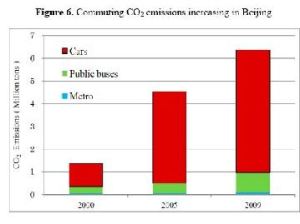Today we review an assessment of commuting emissions for China’s capital city, Beijing, which has undergone large increase in population as well as in size of its suburban areas which has contributed to a four-fold increase in emissions. The journal article attributes the increase in emissions to commuting distance and the shift toward the use of cars which in turn is related to the distance between workplace and home which is a function of urban form. Solutions to achieve sustainable transportation include planned development of housing which would shorten the commuting as well as a greater priority for metro subways over roads for cars.

Key Quotes:
“As the second-largest sector in terms of emissions, transport accounted for 22% of global CO2 emissions in 2010 [5], and its share in the overall energy consumption and emissions is continuously growing, which makes it one of the most important contributors to global CO2 emissions”
“the urban form is a critical determinant for limiting the environmental impact of transportation systems after several decades of studies in developed countries or cities…a strong negative correlation between transport energy consumption and population density.. In addition to density, other quantitative measurements of urban form and structure features, such as size, mixed land uses, compactness, open space, accessibility, and so on, were also used to gauge environmental implications in terms of CO2 emissions for different cities”
“[but in some cases] the densification of urban populations worsen congestion, and does not necessarily contribute to energy conservation,and their work is only valid for certain conditions, i.e., within the central business district (CBD)” “From 2000 to 2009, the total population of Beijing increased by 29%, from 13.64 million to 17.55 million.”
“ Despite the different degree of decentralization of population and employment in Beijing, the urban form of Beijing is still highly centralized by physical form.”
“many employees, especially low income ones, who still work in the urban core, have to choose to live farther away from the traditional urban core in favor of more affordable housing”
“On the whole, from 2000 to 2009, the changing urban form of Beijing had a larger impact on the use of cars (196.3%) and public buses (−63.8%), while the improvement of the transport network of Beijing had a larger impact on metro users (97.2%)”
“Aggregate commuting CO2 emissions was more than four-fold from 1.37 million tons in 2000, to 6.35 million tons in 2009, with a robust average annual growth rate of 19%...CO2 emissions from cars increased more than four times, and its share reached 85% in 2009,”
“commuting distance is, to a very large extent, a determinant for the CO2 emissions of the commuting system…A jobs-housing balance policy has been considered as a strategically useful tool to alleviate congestion and automobile emissions.”








No comments:
Post a Comment